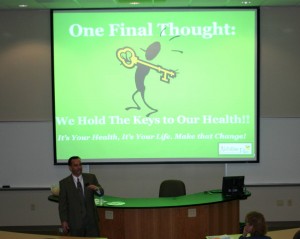| |
 |
Archive for Wellness
October 27, 2010 at 9:07 am
· Filed under , General Nutrition & Wellness, Nutrition, Wellness

Seeing pink? I’m sure you’ve noticed that pink is everywhere this month– the potato chips bags, Facebook profile pictures and even on the football fields. October is Breast Cancer Awareness Month. Companies and charities are donning pink ribbons to increase awareness of this deadly health threat. While I support the cause of awareness, I could rant all day about the idiocy of the placement of a pink ribbon on a fried chicken bucket. Instead, I want to focus on what we women can do to protect ourselves against this serious disease. Below are 10 steps women can take to lower our risk of breast cancer.
1. Eat less saturated & trans fats and replace with monounsaturated fats. Saturated and trans fats can increase cancer risk while monounsaturated fats may lower the risk.
- Saturated fats: Eat less whole milk, fatty cuts of meat, butter, lard, fried foods and fast food.
- Trans fats: Eat less stick margarine, chips, snack crackers, fried foods and fast food.
- Monounsaturated fats: Eat more olive oil, canola oil and nuts. Make olive or canola oils your choice for cooking and use them to make your own salad dressings. Eat a handful of any unsalted or lightly salted nuts each day.
2. Limit your intake of processed foods. The less that has been done to your food, the better. Choose your lean meat and protein foods from the dairy or butcher area instead of the packaged meat or deli area. Foods high in nitrates (hot dogs, bacon, sausage, deli meat) may increase cancer risk.
3. Aim for 2 to 3 cups of vegetables & 3 pieces of fresh fruit every day. Anti-cancer nutrients are abundant in fruits and vegetables. Eating these antioxidants and phytochemicals can provide your body with all kinds of protective benefits. You cannot get the same benefit from a pill or supplement, no matter what the salesperson tells you!
4. Choose whole grains. A high fiber intake may reduce breast cancer by reducing estrogen levels. Choose brown rice and whole wheat breads, cereals, tortillas and pasta. Limit biscuits, white bread products and packaged rice/pasta mixtures.
5. Eat fatty fish at least twice a week. Salmon is one of the highest sources of omega-3 fatty acids (canned salmon works well too!). Bake, broil, pan fry in olive oil or grill it.
6. Limit alcoholic drinks to no more than 1 a day. Alcohol is the one of the largest dietary risk factors because it increases estrogen levels. If you do choose to have a drink, red wine or dark beer are better choices due to their phytochemical content. One drink serving is:
Beer – 12 oz (one bottle)
Wine – 5 oz (a very small glass)
Liquor – 1oz (one shot glass)
7. Keep a healthy weight. Studies show that mid-life weight gain contributes significantly to the risk of breast cancer.
8. Exercise! Aim for at least 45 minutes of activity at least 4 days a week. Schedule it and make it part of your weekly routine.
9. Don’t smoke: If you are a smoker, quit.
10. Breast feed your babies: It reduces your risk of ever getting breast cancer and reduces your babies’ risk of ever developing obesity, diabetes or cancer.
It’s Your Life. It’s Your Health. Make That Change!
~ Angie
Permalink
August 25, 2010 at 11:49 am
· Filed under General Nutrition & Wellness, Nutrition, Wellness
Ahhhh….my favorite time of year—football season. I’m assistant coach to my son’s tackle football team this year. I put this info together and shared it with our team and their parents. I brought in “urine specimen” cups for them to view how their urine looks when they are well and not-so-well hydrated. The kids went nuts when I tried to drink the “specimens”, but I think they will remember this easy way for them to gage their own hydration status.
Fueling Your Athlete
To maximize performance in the classroom AND on the field, it is important to pay attention to the foods we eat. Proper nutrition can help your child feel better, be more alert and learn more. During competition, adequate nutrition can help your child stay injury free or recover quicker if injured. Good nutrition does not have an off-season. To get the most benefit, you need to start now and continue throughout the year. Remember, you set the example for your family!
The Nutrition Playbook:
1. Start each day with Breakfast!
Any food can count toward breakfast. Be sure to include fruit, grains, proteins and dairy.
2. Focus on powerhouse foods:
- Fresh or Frozen Fruits and Vegetables: give energy and nutrients needed to stay active, focused and healthy
- Aim for 2 pieces of fresh fruit and 1-2 cups of Vegetables everyday. Fruit juices are a source of liquid and nutrients but more benefit comes from eating the whole fruit.
- Lean Sources of Protein: help build new muscle and repair damaged tissues. Baking, grilling, broiling boiling or steaming are great ways to prepare meats. Lean choices include:
- Fresh or frozen Fish, Canned Tuna or Salmon
- Skinless Chicken Breast
- Eggs
- Peanut Butter
- 1%, 2% or Part Skim Cheese
- Whole Grains, breads and cereals: are great source of vitamins, minerals and fiber. They provide a strong source of Carbohydrates, the body’s preferred fuel source! Sources include:
- Oatmeal, Grits or Whole Wheat Cold Cereals
- Whole Wheat Breads, English Muffins, Tortillas
- Wheat Pasta, Brown Rice
3. Drink 8 oz of 1% or Fat Free Milk or Eat Yogurt at least twice everyday! Milk supplies protein and carbohydrate and is an excellent source of calcium, potassium and many other important nutrients!
4. Plan on adding snacks during the day to fit around practices and games.
- Snack Ideas: [Good to use as pre or post game snack!]
- Peanut Butter Crackers, graham crackers or sandwich with a Banana and Glass of Milk
- Cup of Yogurt, piece of fruit, and pretzels with water
- Cup of Yogurt with granola cereal
- 3 Fig Newton’s with a glass of water or milk
- Cheese and crackers, grapes, and water
- Homemade Trail Mix: Handful of nuts (any type will work) mixed with a ½ handful of dried fruit (raisins, cranberries, apricots, etc.)
- Celery and or Apple with peanut butter
- Cereal and low fat milk. Add some fruit!
5. Limit Fast Foods! Most restaurant meals short change you in fruits and vegetables and contain excessive amounts of sodium. If you choose fast foods, make sure to add fresh fruit to the meal and choose Low Fat (1%) or Fat Free (Skim) milk in place of sodas or tea.
6. Stay hydrated during the day by drinking plenty of fluids.
You should be urinating at least every 2-3 hours. Sports drinks may help some, but your first choice should be water. You can monitor urine color to get a better idea of how well hydrated you are. Try to keep urine color between the numbers 1 and 3. (See chart below)

You do not want your urine to be totally clear as that could signify over-hydration. Also keep in mind, certain medications, vitamins and herbal supplements can cause urine colors to change.
7. Rest and Recovery! Games and practices can make it difficult to keep a regular sleep pattern. It is important to get proper rest to help reduce risk of injuries and provide for time to recover from training. Get a jump on nutrition by planning meals and snacks in advance to help when time becomes limited.
| |
| |
| Here’s to a Healthy and Safe Sports Season! |
|
It’s Your Health. It’s Your Life. Make That Change!
~John
Permalink
June 3, 2010 at 3:58 pm
· Filed under General Nutrition & Wellness, Nutrition, Wellness

It’s Farmer’s Market season. Local open air markets are a great opportunity to do something good for your health. As we have said numerous times before, increasing our fruit and vegetable intake is one of the best things we can do for our bodies. Fruits and vegetables are low in calories but enormously high in nutrition.
Local or home-grown fruits and vegetables are usually highest in nutrition. They are freshly picked and have not been traveling long distance on a truck or sitting in a warehouse. They do not have to travel far to their destination—your table!
Another great and fun advantage is that you get to meet the people who have grown your food. You can ask them how to prepare the particular fruit or vegetable. Farmers really enjoy sharing their knowledge about their produce and providing you with recipes and/or preparation tips.
Additionally, you are helping to stimulate your local economy as well as keep your local farmers in business. Want to eat “organic”? Many local farmers practice organic farming. Just ask them about it.
Want to find markets in your local area? Check out this site http://www.localharvest.org/. Just plug in your zip code and it will find farmer’s markets in your local area.
In Elizabeth City, NC, we have the Downtown Waterfront Market every Saturday from 9am until 1pm through October 30 this year. Visit www.downtownwaterfrontmarket.com for more information.
So, make plans to visit a local farmer’s market this weekend. Enjoy the sights, sounds, and fresh air. Pick up a fruit or vegetable that you have never eaten. You may discover a new summertime favorite!
It’s your Health! It’s Your Life! Make That Change!
~ Angie
Permalink
January 22, 2010 at 1:22 pm
· Filed under General Nutrition & Wellness, Wellness
There was an interesting study which was released earlier this month. The study looked at the Nutrition Facts from selected restaurant and packaged food products. They compared what was listed versus what was actually found in the foods when tested in a laboratory. Check out original release here. Unfortunately, the findings of the study showed that most restaurants and some of the packaged food product companies significantly underestimated the amount of total calories contained in their products. It appears that one of the reasons for the discrepancies comes from portion size served versus the portion size estimate. The study focused on calories only.
Let’s take this a step further. Calories do not tell the whole story. We are all aware of Subway and their ‘healthier’ choices and lower fat options. McDonald’s also promotes healthy options. KFC, formerly, Kentucky FRIED Chicken and now even Taco Bell have ‘healthy’ fare. Heck, Taco Bell is trying to steal some of Subway’s promo action by pushing their own ‘Drive Thru Diet’ plan with “Christine” as their “Jared”. What I find interesting in this whole exchange is that nobody is pushing fresh fruits & vegetables AND nobody seems to be concerned that the ‘healthy’ options can be very high in sodium.
Should we be concerned about sodium? Well, if you have High Blood Pressure, Chronic Kidney Disease, Congestive Heart Failure, take diuretics (fluid pills), or have a problem with fluid retention, then the answer is a resounding “YES!” Sodium can increase fluid retention which can cause an increase in blood pressure. Americans tend to get too much sodium from our foods. We only need about 500-1,000 mg a day to sustain life. But recent estimates place the average daily intake at about 4,000-5,000 mg a day. (For a point of reference, a teaspoon of salt contains about 2,300 mg of sodium). Most health organizations today are encouraging people to keep sodium intake to no more than 2,400 mg a day. Angie & I encourage our clients to limit intake to no more than 2,000 mg a day.
What we must increase our awareness of is that the sodium intake in our diets comes predominantly from our food choices NOT the salt shaker. Processed foods, restaurant food, fast foods, snack foods and canned products all contain significant amounts of added sodium. As we tend to prepare less foods at home and eat fewer fresh fruits and vegetables, the sodium levels in our diets will continue to rise. The problem with our increasing intake of sodium is that the salt flavor is an accquired taste. The more we get, the more we want. Long-term, high sodium intakes can increase your risk of developing high blood pressure and heart disease. Because it takes time for the cumulative effects to add up, we don’t pay as close attention to our food choices. Sodium in your diet can sneak up on you.
Let’s turn our focus back to those fast food companies and their push to get us to look for lower fat & calorie options: Links to the companies web site for nutriton facts are provided:
- Subway’s 8 choices of subs with 6 grams of fat or less. Only one option has a sodium content of less than 500 mg. The 6″ Black Forest Ham Sub has 1200 mg of sodium. If you add a bag of chips, that adds at least another 200 mg!
- McDonald’s Premium salads sodium content varies. Without chicken, the salads range from 150-300 mg of sodium. Add chicken to the salad and you increase the sodium 600-800 mg. Throw in a bag of Croutons and add another 140 mg. Pour on salad dressing and you have to add another 340-730 mg of sodium. The side salad is listed as having only 10 mg of sodium.
- The Taco Bell Drive Thru Diet Fresco Menu has 7 items with less than 9 grams of fat. However, the lowest sodium choice, the Fresco Crunchy Taco has 350 mg of sodium. By itself that is acceptable. The other choices from the Fresco Menu have anywhere from 600 to 1410 mg of sodium.
- KFC’s Grilled Chicken options have been getting a lot of attention. While they are lower in fat, you must still think about the sodium content. They do have a lower sodium content than many of the other examples we’ve been talking about. However, most orders also include sides. The sodium content of the grilled chicken choices range from 230 to 550 mg. The grilled chicken breast comes in at the highest with 550 mg but it also provides you with the largest amount of food. Add a side of green beans and you add 380 mg of sodium. Complete your meal with a side of mashed potatoes without gravy and the sodium increase another 350 mg. A meal with a grilled whole wing, side of green beans and side of mashed potatoes without gravy would give you over 900 mg of sodium!
Keep in mind the total daily intake of sodium we are recommending–around 2000 mg a day. That equates to about 600-700 mg per meal. Eating out makes it difficult to hit those goals. I’m not saying you should stay away from fast foods or never go out to eat but I want you to be aware of what you are getting. Don’t just look at the fat and calories. Look at the whole picture. You can make better choices by leaving off dresings, gravies, sauces, cheeses and mayonaisse. Resist the french fries, onion rings, tater tots & biscuits and you’ll save more in the way of calories, fats and sodium. I encourage our clients to take a piece of fruit with them if they are going out to eat. Have that at the end of your meal in place of a dessert and you will definitely come out ahead. As we always say, prepare more foods at home and concentrate on trying to eat more fruits and vegetables!
~It’s Your Health. It’s Your Life. Make That Change!
~John
Permalink
November 19, 2009 at 6:10 am
· Filed under , General Nutrition & Wellness, Nutrition, Wellness
Fall is our busiest season. School is back in the session, the children are busy with fall sports and we are traveling to college football games. However, I would have to say that it is my favorite. I love making gingerbread with the kids and the awesome smell that carries through the house. I love relaxing at the end of a busy day to George Winston’s “Autumn”. I love the crisp coolness and excitement in the air at college football games. But, one of my all-time favorite things to do in the fall is to run. There is something about a run in the fall that is different from any other time of the year. It is a treat for the senses. The sound of the crackling leaves under your feet, the smell of the wood fires burning in the chimneys, the feel of the cool air, the look of the vibrant colors in the changing leaves and coral sunrises. The bugs are gone and the humidity is down. Madison, our ten year old Lab, feels it too as she is finally willing to leave from below the shaded tree and join me for the cool down.
Running, just like any exercise, makes you feel good. When you exercise aerobically, you release endorphins. Those endorphins reduce stress and improve your mood. Whenever I feel tense, exercise always makes me feel more relaxed. The more hectic life gets, the more exercise seems to help me cope. If I have tough decisions to make, it seems gives me a clear head in which to think.
Many people know about how exercise can help you to lose or maintain weight, control blood sugar levels and improve overall fitness. But, one very important aspect of exercise that is often overlooked is how it can improve your mood.
So, get out and enjoy the good things that both fall and exercise offer. If you are not a runner, go for a walk. You will be surprised at how good it will make you feel, both physically and emotionally!
~ Angie
It’s Your Health. It’s Your Life. Make that change!
Permalink
November 6, 2009 at 5:41 pm
· Filed under General Nutrition & Wellness, Wellness
I usually do not title a Nutrition Blog with a political quote but this one fits….From JFKs inaugural address, January 20th, 1961, “…ask not what your country can do for you – ask what you can do for your country.”
We are hearing everyday how our country needs health care reform. We are being told that we are in a health care crisis. Democrats & Republicans alike have thoughts on what reform should be or look like. I’m not here to debate the issue of reform. There is no question we need changes in many things. From prescription drug costs to health care costs, we pay dearly for ways to bring us good health. But, are we healthier? In the debating of the reform process, there has been some talk of increasing reimbursement for preventative care. That is a nice start. However, the major disappointment I feel stems from the fact that there has not been a call for increasing personal responsibility. We all want somebody to shoulder the costs of health care reform. We complain about the cost of prescription medications, the high co-pay fees and health insurance. Where we need to start, though, is with ourselves. Our lifestyles lead us to increasingly bad health. Sure, you can make the argument that you have the right to choose how you live. I am all for that. But what happens when you get sick? Many research studies have looked at the impact that lifestyle plays on our health. Do we need studies telling us that fast foods are not healthy, that high sodium diets can cause high blood pressure, that diets low in fruits & vegetables can lead to a variety of illnesses? For confirmation of that, we don’t need to look much further than the current increase of Type 2 diabetes in our youth. Twenty years ago, that was unheard of. Today, as our children become more overweight and obese, it has become common place.
The time has come for each of us to take health care reform into our own hands. Each of us hold the keys to better health. We don’t need government sponsored plans to set a healthier path. Look around and seriously assess your lifestyle choices. From foods to alcohol to smoking to physical activity. Are you choosing habits that will help or harm you in the long run?
People often tell us that it is too expensive to eat healthy. Sometimes it may be more costly to eat healthier. But think of that cost as an investment in your future. The cost of getting sick is much more than the cost of eating healthy! It’s funny that people have no problem spending money on the latest gadgets, HD TVs, cars, hair styles,….yet fail to look at what they eat, or how physically active they are. Unfortunately, I can not promise you a longer life or total freedom from sicknesses if you make those changes. But, I can offer you a better chance to beat those sicknesses and the opportunity to lead a more active , and possibly, productive life.
“And so, my fellow Americans: ask not what your country can do for your health – ask yourself what you can change to improve it!”
Like we say at Nutrition Pair, “It’s Your Health. It’s Your Life. Make That Change!” We believe that each of us have the potential to lead healthier lives. Don’t wait for the government to make a change. Start it yourself. Challenge yourself to eat an extra piece of fruit everyday, dine out less often, prepare more foods at home, eat more broccoli or other vegetables, or walk an extra 15 minutes. Challenge yourself to learn more, do more and get healthier. Remember……
“It’s Your Health. It’s Your Life. Make that Change!”
~John
Permalink
March 11, 2009 at 5:14 pm
· Filed under General Nutrition & Wellness, Professional Interest, Wellness
Happy Registered Dietitian Day! Today marks the 2nd annual Registered Dietitian Day sponsored by the American Dietetic Association (ADA). Look for the ADA to ring the Opening Bell for the NASDAQ stock exchange tomorrow morning, March 12th in recognition of National Nutrition Month and Registered Dietitian Day.
What makes you unique? We all have our own distinctive traits that make us different from the person sitting next to us. This is what makes us special. And, this is why personalized service is so important. It gives us the freedom to choose what we want when we want it. Our MP3’s are loaded with OUR favorite songs. Our DVR’s tape our favorite sports or shows so that we can watch them at a time that is most convenient for us. Even children are getting into personalization. They can go to “Build a Bear Workshop” and fashion a bear that reflects their own special interests.
You are unique. You deserve individualized attention.
When it comes to improving health, it should be no different. Look for a program that can be customized for your lifestyle: your schedule, your health goals, your medical history, your meds, your culinary skills, your own cultural foods and your financial situation. Personalization can make the difference between success and failure. This is why diets don’t work. They don’t tell you what to do when you go to eat at a friend’s house and they are not serving Week 2’s Thursday Supper Meal. Diet books don’t talk back to you and are not always written by Nutrition Experts, or Registered Dietitians. You need the knowledge and skills to make your flexible choices on your own terms.
An eating plan should fit your lifestyle, not the other way around. This is where a Registered Dietitian (RD) comes in. We get personal. Find yourself a personal nutrition coach, a Registered Dietitian. We can create a customized plan that fits your own unique lifestyle and values. Working on-on-one with your own RD to develop a plan together, taking in your own wants and needs can be exciting. RD’s help people who want customized plans because of our in-depth training and knowledge of nutrition, medical issues, and food. We are uniquely qualified to assess and counsel an individual with any kind of medical history or lifestyle.
Nutrition Pair will work with you on your terms, on your time schedule with your own goals in mind. No diets allowed. Contact us to set up an individualized on-line, phone or face-to-face appointment!
It’s Your Health. It’s Your Life. Make that change!
~Angie
Permalink
February 6, 2009 at 12:10 pm
· Filed under , Wellness
 Be Heart Healthy at any Age! Are you wearing your red today? Today is National Wear Red Day. Americans nationwide are sporting red dresses, red blouses or red ties today to raise awareness that heart disease is the #1 killer of women. National Wear Red Day starts The Heart Truth Campaign to celebrate February as American Heart Month.
The Heart Truth and the introduction of the Red Dress as the national symbol for women and heart disease awareness were initiated in 2002 by the National Heart, Lung, and Blood Institute (NHLBI) and partner organizations. Read more about it here. The campaign is geared toward women between the ages of 40 to 60, which is the period in which a woman’s risk for heart disease begins to significantly increase. However, the message is also important for young women as heart disease can begin to develop as early as the teenage years. Older women have an interest too as it is never too late to take measures to prevent and control heart disease risk factors. For women who may already have heart disease, it is important to note that existing heart disease can be reversed through diet and lifestyle change.
Take a look at these stats:
-
Women are twice as likely to die from heart disease than from all cancers combined
-
39% of women who have heart attacks do not survive their first attack
-
More women who have heart attacks die within one year compared to men
-
One in two women will have serious heart trouble in their lifetime
-
Women with heart disease have different symptoms than men
The largest risk factor for heart disease, by far, is smoking. Other risk factors include African American or Hispanic heritage, obesity, physical inactivity, high blood pressure, diabetes and family history of heart disease. What measures can women take to prevent heart disease?
-
If you are a smoker, stop!
-
Begin a physical activity program
-
Control blood pressure/blood sugar levels if you have HTN or diabetes
-
Eat right. Adopt a Mediterranean-style or DASH Diet-style of eating
-
Include omega 3 fats in your diet (salmon, mackerel, flax, walnuts are good sources)
-
Practice relaxation techniques
-
Seek appropriate management for medical conditions
Remember, a Registered Dietitian can be a true asset in helping to design an individualized eating plan for you to help you in meeting your weight loss, blood pressure or diabetes management goals.
Wear red today and help spread the critical message that heart disease is the #1 killer of women and that there are things that women can do, starting today, to reverse their risk of heart disease.
It’s Your Health. It’s Your Life. Make that change!
~ Angie
Permalink
January 19, 2009 at 2:05 pm
· Filed under General Nutrition & Wellness, Nutrition, Professional Interest, Wellness
Nutrition Pair participated in the North Carolina State Medical Assistants (NCSMA) Winter Seminar, “Bridging the Gap to Healthcare” held January 17th at College of the Albemarle here in Elizabeth City. There were 86 medical assistants from across the state in attendance.
We exhibited at the conference and John provided the nutrition presentation “Discovering Your Path to Wellness”. In it, he reviewed the current health of our nation as well as that of North Carolina. For example, in North Carolina, 61% of adults are overweight or obese and 27% of adolescents are either overweight or at risk of becoming overweight (CDC, 2003). Focusing on the health risks associated with poor lifestyle choices, John discussed ways for the attendees to improve their own health as well the health of their patients. He stressed how important it is that we serve as healthy role models for our clients. We also encouraged referring to a Registered Dietitian for Medical Nutrition Therapy for chronic disease management as well as prevention. The NCSMA is a fun and lively group and we enjoyed being a part of their winter seminar.
It’s Your Health. It’s Your Life. Make That Change!
~ Angie
 Nutrition Pair Exhibit at NCSMA  "Discovering Your Path to Wellness"
Permalink
« Previous Page — � Previous entries « Previous Page · Next Page » Next entries � — Next Page »
|
 |
|
|








